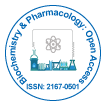
Biochemistry & Pharmacology: Open Access
Open Access
ISSN: 2167-0501

ISSN: 2167-0501
Perspective - (2025)Volume 14, Issue 1
Inflammation is a complex physiological response triggered by infection, injury, or immune dysregulation. While acute inflammation is protective and necessary for tissue repair and defense against pathogens, chronic inflammation underlies numerous pathologies including rheumatoid arthritis, inflammatory bowel disease, psoriasis, asthma and even metabolic and neurodegenerative disorders. The development of pharmacological agents that specifically target key inflammatory biochemical pathways offers a promising strategy for mitigating such conditions. The intricate network of cellular and molecular mediators involved in inflammation such as cytokines, chemokines, prostaglandins, leukotrienes and reactive oxygen species provides multiple potential targets for drug intervention. Understanding these pathways at the molecular level is essential for designing therapeutic agents that can selectively suppress pathological inflammation while preserving normal immune function.
Central to inflammatory signaling is the activation of nuclear factor kappa B, a transcription factor that regulates the expression of numerous pro-inflammatory genes including interleukins, tumor necrosis factor-alpha and cyclooxygenase-2. Aberrant or sustained activation of NF-κB has been implicated in chronic inflammatory diseases and cancer. Inhibitors targeting NF-κB signaling, either through direct inhibition of the IκB kinase complex or interference with upstream toll-like receptor signaling, are currently under investigation. Similarly, the Janus kinase/signal transducer and activator of transcription pathway has emerged as a critical mediator of cytokine signaling. The success of JAK inhibitors like tofacitinib in the treatment of rheumatoid arthritis and ulcerative colitis highlights the therapeutic potential of targeting this pathway. However, due to the broad role of JAKs in immune signaling, selectivity and adverse effects remain significant considerations.
Another promising avenue in anti-inflammatory drug development is the targeting of lipid mediators. The arachidonic acid cascade produces a range of pro-inflammatory and anti-inflammatory eicosanoids through the action of cyclooxygenases, lipoxygenases and cytochrome P450 enzymes. Non-steroidal anti-inflammatory drugs, such as ibuprofen and diclofenac, exert their effects by inhibiting COX enzymes, reducing prostaglandin synthesis. However, chronic NSAID use is associated with gastrointestinal, renal and cardiovascular side effects due to the inhibition of protective prostanoids. This has spurred the development of more selective COX-2 inhibitors (e.g., celecoxib) and dual COX/LOX inhibitors aimed at preserving gastrointestinal integrity while reducing inflammation. Additionally, the role of specialized pro-resolving mediators such as resolvins and protectins, derived from omega-3 fatty acids, has gained attention for their ability to actively resolve inflammation without immunosuppression. Harnessing these endogenous molecules or developing analogs represents a novel and physiologically aligned approach to anti-inflammatory therapy.
Natural compounds and phytochemicals, such as curcumin, resveratrol and quercetin, have also shown efficacy in modulating inflammatory pathways through multi-target mechanisms. Though many of these compounds have demonstrated anti-inflammatory effects in vitro and in animal models, challenges with bioavailability, stability and pharmacokinetics have limited their clinical utility. Efforts to enhance delivery through nanoformulations or structural analogs are ongoing and may lead to improved therapeutic candidates. Additionally, the role of the gut microbiota in modulating inflammation has opened new research directions in probiotic and prebiotic therapies, emphasizing the systemic nature of immune and inflammatory responses.
In conclusion, the development of anti-inflammatory pharmacological agents requires a nuanced understanding of the biochemical pathways that govern immune responses. While current therapies such as NSAIDs and corticosteroids provide symptomatic relief, their limitations highlight the need for more targeted and safer alternatives. Advances in molecular biology, high-throughput screening and systems pharmacology have accelerated the identification of novel targets, including cytokine signaling pathways, lipid mediators, inflammasomes and redox-sensitive transcription factors. As our understanding of inflammation deepens, future therapeutic strategies will likely involve combination therapies that address multiple nodes of the inflammatory cascade, tailored to individual disease profiles. This integrative approach holds the promise of achieving more effective and sustainable control over chronic inflammation, improving outcomes for patients worldwide.
Citation: Cardenas ML (2025). Targeting Inflammatory Biochemical Pathways for the Development of Anti-Inflammatory Pharmacological Agents. Biochem Pharmacol.14:389.
Received: 03-Feb-2025, Manuscript No. BCPC-25-37582 ; Editor assigned: 05-Feb-2025, Pre QC No. BCPC-25-37582 (PQ); Reviewed: 19-Feb-2025, QC No. BCPC-25-37582 ; Revised: 26-Feb-2025, Manuscript No. BCPC-25-37582 (R); Published: 04-Mar-2025 , DOI: 10.35248/2167-0501.25.14.389
Copyright: © 2025 Cardenas ML. This is an open-access article distributed under the terms of the Creative Commons Attribution License, which permits unrestricted use, distribution, and reproduction in any medium, provided the original author and source are credited.